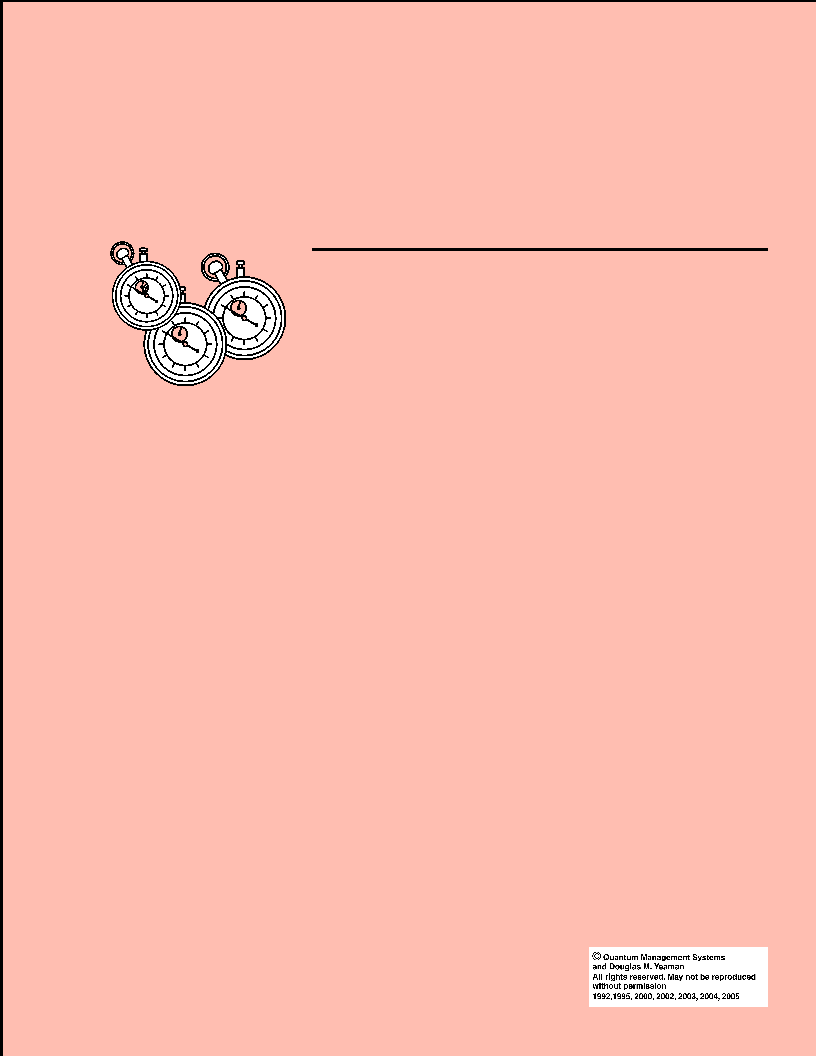





Many of us realize that effective
time planning and management
are essential. Still many of us do
not incorporate good time manage-
ment techniques into our daily
schedule. The purpose of this
article is to highlight the essential
elements of effective time manage-
ment and to provide some insight into
where and why time is misspent
It is important in utilizing time management principals that we under-
stand certain basic components.
The first component is realistic identification of productive and nonpro-
ductive tasks. Most lists are either dishonest or wrong.
The second component of the system is a written plan. Planning without
writing is daydreaming and will not support your goals. The form of such a
plan is not important; however, it must contain a daily schedule for listing
appointments and activities.
The third component of the system is a clear understanding of the terms
related to time.
What is time planning? Time planning involves recording what you are
going to do each day, week, and month. It is essential that you spend at least
one-half hour each day making a daily work plan. The plan must establish a
priority ranking.
What is time management? Time management is carrying out minute-to
minute and hour-to-hour planned activities.
How do we know what to do? The only effective way is to have a set of
written goals and a step-by-step list of written objectives or activities which
will accomplish the goals. Goals are long-range, direct results of primary and
secondary objectives. Objectives are short-range activities.
A written statement noting goals and objectives is the cornerstone of a
good time management system. To achieve a goal, clearly write it down, list the
sort-range objectives of attaining it, and make a commitment to do objectives.
We are in fact, the sum of commitments we have either kept or broken.
Commitments must be specific, actionable and contained in time. For instance,
“I’ll make five cold calls by 10 o’clock.”
Most time management systems break down at this point. To avoid this,
you must recognize that you get what you want in life as a direct function of
the price you are willing to pay. The price is keeping your commitments. You
can always recognize a true commitment by the result. If you made five cold
calls by 10 o’clock, you had a commitment. If you did not make the five calls,
you did not have a commitment. In other words, a commitment is not a com-
mitment when it is made. It is only a commitment when it is kept.
We know a time management system must incorporate things to do, written down
in a priority-listed, daily planner, and that we must be committed to our plans.
Seems simple doesn’t it? Many of us have done these things and obtained a certain
level of success. the question is how can we earn more money in the same amount
More Money in
Less Time
By John Spalding
of time or the same amount of money in
less time. The key to doing this in real
estate is contacting people. You must
be committed to a consistent, methodi-
cal basis with continuous follow-up.
The best tool to insure more contact
with people is to identify those tasks
which lead to such contact.
Next, use your time management sys-
tem to analyze the exact amount of time
you spend doing those activities each
week. If you are not spending enough
time in people contact work, you can
change your objectives and activities to
bring them more in line with your goals.
People contact is the basis for success
in real estate. So let’s define basic cate-
gories of activities as they relate to such
contact. These categories include:
I=intermediately productive time
P=productive time
N=non-productive time
Intermediately productive time (I-
time) is that time spent making a direct
contribution toward face-to-face con-
tact in a selling situation with a client.
Productive time(P-time) is that time
spent in face to face contact in a selling
situation with a client. Non-produc-
tive time (N-time) is time spent doing
everything else. This does not mean
that nonproductive activities are not
important. In fact, nonproductive ac-
tivities may be crucial and take prece-
dence over I and P items; however, no
matter how pressing or important N
items are they will never directly lead
you into people contact.
It is essential to the success of
your sales effort that you carefully
LASR\MOREMONY.PM3 KDL 12/91
This material is protected by copyrights and
my not be used without permission of Quan-
tum Management Systems and Doug Yeaman


